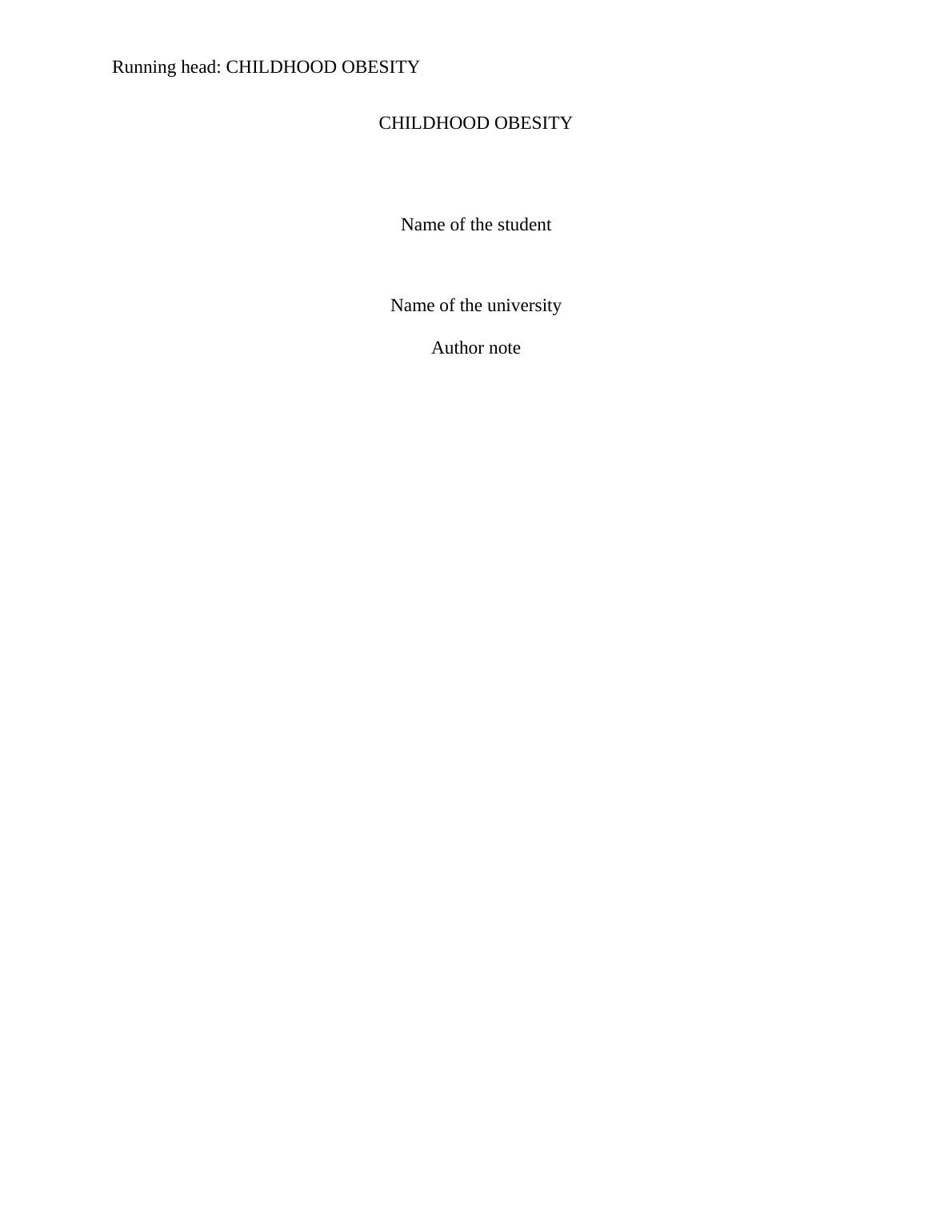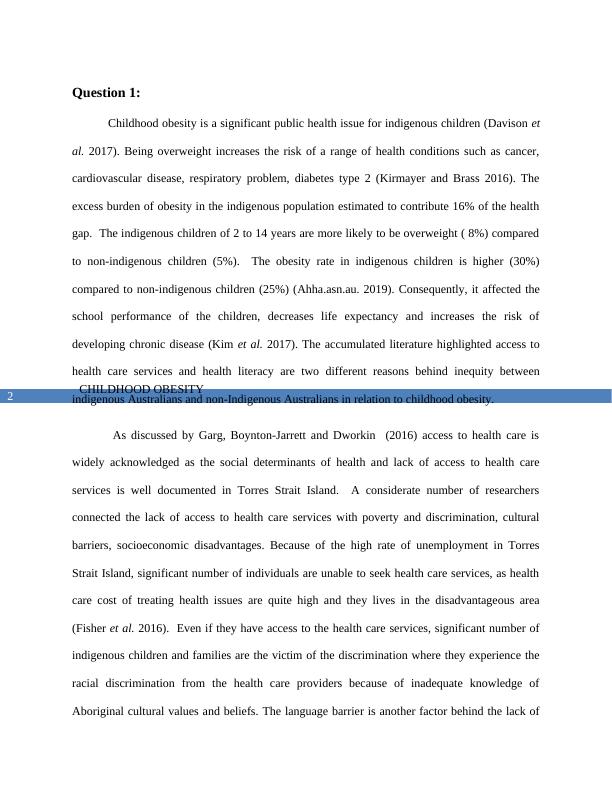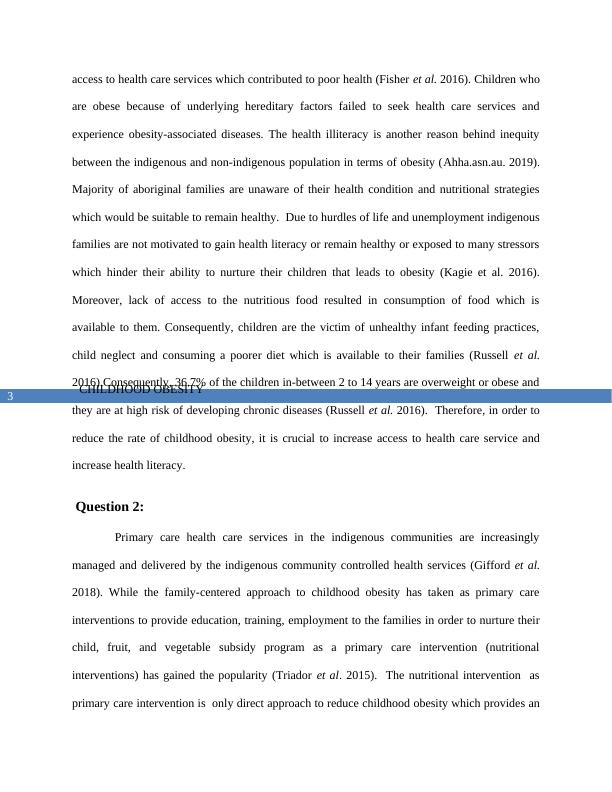Childhood Obesity: Indigenous Children and Health Disparities
Added on 2023-01-04
9 Pages2566 Words70 Views
Running head: CHILDHOOD OBESITY
CHILDHOOD OBESITY
Name of the student
Name of the university
Author note
CHILDHOOD OBESITY
Name of the student
Name of the university
Author note

CHILDHOOD OBESITY
2
Question 1:
Childhood obesity is a significant public health issue for indigenous children (Davison et
al. 2017). Being overweight increases the risk of a range of health conditions such as cancer,
cardiovascular disease, respiratory problem, diabetes type 2 (Kirmayer and Brass 2016). The
excess burden of obesity in the indigenous population estimated to contribute 16% of the health
gap. The indigenous children of 2 to 14 years are more likely to be overweight ( 8%) compared
to non-indigenous children (5%). The obesity rate in indigenous children is higher (30%)
compared to non-indigenous children (25%) (Ahha.asn.au. 2019). Consequently, it affected the
school performance of the children, decreases life expectancy and increases the risk of
developing chronic disease (Kim et al. 2017). The accumulated literature highlighted access to
health care services and health literacy are two different reasons behind inequity between
indigenous Australians and non-Indigenous Australians in relation to childhood obesity.
As discussed by Garg, Boynton-Jarrett and Dworkin (2016) access to health care is
widely acknowledged as the social determinants of health and lack of access to health care
services is well documented in Torres Strait Island. A considerate number of researchers
connected the lack of access to health care services with poverty and discrimination, cultural
barriers, socioeconomic disadvantages. Because of the high rate of unemployment in Torres
Strait Island, significant number of individuals are unable to seek health care services, as health
care cost of treating health issues are quite high and they lives in the disadvantageous area
(Fisher et al. 2016). Even if they have access to the health care services, significant number of
indigenous children and families are the victim of the discrimination where they experience the
racial discrimination from the health care providers because of inadequate knowledge of
Aboriginal cultural values and beliefs. The language barrier is another factor behind the lack of
2
Question 1:
Childhood obesity is a significant public health issue for indigenous children (Davison et
al. 2017). Being overweight increases the risk of a range of health conditions such as cancer,
cardiovascular disease, respiratory problem, diabetes type 2 (Kirmayer and Brass 2016). The
excess burden of obesity in the indigenous population estimated to contribute 16% of the health
gap. The indigenous children of 2 to 14 years are more likely to be overweight ( 8%) compared
to non-indigenous children (5%). The obesity rate in indigenous children is higher (30%)
compared to non-indigenous children (25%) (Ahha.asn.au. 2019). Consequently, it affected the
school performance of the children, decreases life expectancy and increases the risk of
developing chronic disease (Kim et al. 2017). The accumulated literature highlighted access to
health care services and health literacy are two different reasons behind inequity between
indigenous Australians and non-Indigenous Australians in relation to childhood obesity.
As discussed by Garg, Boynton-Jarrett and Dworkin (2016) access to health care is
widely acknowledged as the social determinants of health and lack of access to health care
services is well documented in Torres Strait Island. A considerate number of researchers
connected the lack of access to health care services with poverty and discrimination, cultural
barriers, socioeconomic disadvantages. Because of the high rate of unemployment in Torres
Strait Island, significant number of individuals are unable to seek health care services, as health
care cost of treating health issues are quite high and they lives in the disadvantageous area
(Fisher et al. 2016). Even if they have access to the health care services, significant number of
indigenous children and families are the victim of the discrimination where they experience the
racial discrimination from the health care providers because of inadequate knowledge of
Aboriginal cultural values and beliefs. The language barrier is another factor behind the lack of

CHILDHOOD OBESITY
3
access to health care services which contributed to poor health (Fisher et al. 2016). Children who
are obese because of underlying hereditary factors failed to seek health care services and
experience obesity-associated diseases. The health illiteracy is another reason behind inequity
between the indigenous and non-indigenous population in terms of obesity (Ahha.asn.au. 2019).
Majority of aboriginal families are unaware of their health condition and nutritional strategies
which would be suitable to remain healthy. Due to hurdles of life and unemployment indigenous
families are not motivated to gain health literacy or remain healthy or exposed to many stressors
which hinder their ability to nurture their children that leads to obesity (Kagie et al. 2016).
Moreover, lack of access to the nutritious food resulted in consumption of food which is
available to them. Consequently, children are the victim of unhealthy infant feeding practices,
child neglect and consuming a poorer diet which is available to their families (Russell et al.
2016).Consequently, 36.7% of the children in-between 2 to 14 years are overweight or obese and
they are at high risk of developing chronic diseases (Russell et al. 2016). Therefore, in order to
reduce the rate of childhood obesity, it is crucial to increase access to health care service and
increase health literacy.
Question 2:
Primary care health care services in the indigenous communities are increasingly
managed and delivered by the indigenous community controlled health services (Gifford et al.
2018). While the family-centered approach to childhood obesity has taken as primary care
interventions to provide education, training, employment to the families in order to nurture their
child, fruit, and vegetable subsidy program as a primary care intervention (nutritional
interventions) has gained the popularity (Triador et al. 2015). The nutritional intervention as
primary care intervention is only direct approach to reduce childhood obesity which provides an
3
access to health care services which contributed to poor health (Fisher et al. 2016). Children who
are obese because of underlying hereditary factors failed to seek health care services and
experience obesity-associated diseases. The health illiteracy is another reason behind inequity
between the indigenous and non-indigenous population in terms of obesity (Ahha.asn.au. 2019).
Majority of aboriginal families are unaware of their health condition and nutritional strategies
which would be suitable to remain healthy. Due to hurdles of life and unemployment indigenous
families are not motivated to gain health literacy or remain healthy or exposed to many stressors
which hinder their ability to nurture their children that leads to obesity (Kagie et al. 2016).
Moreover, lack of access to the nutritious food resulted in consumption of food which is
available to them. Consequently, children are the victim of unhealthy infant feeding practices,
child neglect and consuming a poorer diet which is available to their families (Russell et al.
2016).Consequently, 36.7% of the children in-between 2 to 14 years are overweight or obese and
they are at high risk of developing chronic diseases (Russell et al. 2016). Therefore, in order to
reduce the rate of childhood obesity, it is crucial to increase access to health care service and
increase health literacy.
Question 2:
Primary care health care services in the indigenous communities are increasingly
managed and delivered by the indigenous community controlled health services (Gifford et al.
2018). While the family-centered approach to childhood obesity has taken as primary care
interventions to provide education, training, employment to the families in order to nurture their
child, fruit, and vegetable subsidy program as a primary care intervention (nutritional
interventions) has gained the popularity (Triador et al. 2015). The nutritional intervention as
primary care intervention is only direct approach to reduce childhood obesity which provides an

End of preview
Want to access all the pages? Upload your documents or become a member.
Related Documents
Introduction It has been Seen that the Aboriginal Peoplelg...
|1
|1699
|12
Why Indigenous Peoples Globally Experience Health Disparitieslg...
|6
|1388
|12
Role of Social Workers in Aboriginal Communitylg...
|8
|1536
|185
Obesity and Community Childrenlg...
|1
|532
|42
Impact of European Settlement on the Aboriginal Population- Reportlg...
|4
|755
|627
Childhood Obesity: Inequity and Interventionslg...
|9
|2788
|48
